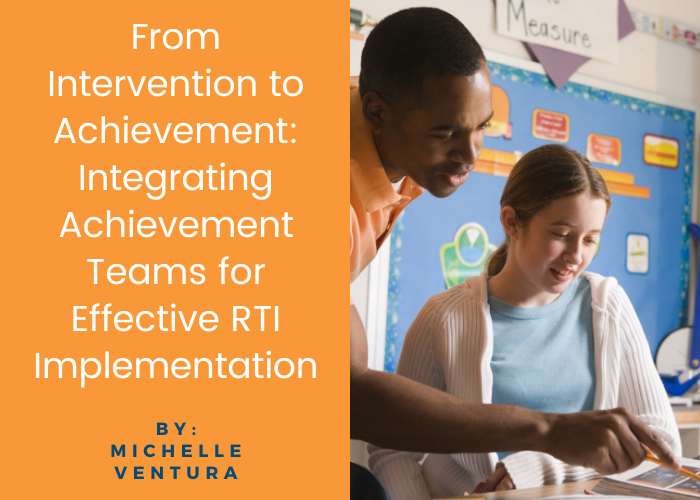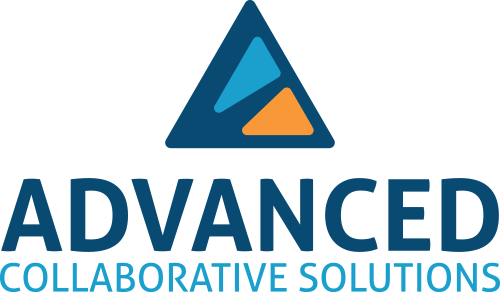From Intervention to Achievement: Integrating Achievement Teams for Effective RTI Implementation

By: Michelle Ventura
Under the massive umbrella that is Multi-Tiered System of Supports (MTSS), there are two frameworks educators leverage to meet individual student’s unique behavioral and academic needs to ensure success for all. These frameworks are behavior support (often Positive Behavioral Interventions and Supports, or PBIS) and Response to Intervention (or RTI), and given the unprecedented and lingering effects of pandemic learning loss, these frameworks are more important than ever.
However, while important, intricate intervention systems often leave educators, schools, and districts spinning and at a loss of which actions are most effective for student success. Enter Achievement Teams.
Defining Achievement Teams and RTI
Achievement Teams is a collaborative protocol that focuses on gaining new knowledge about teaching and learning rather than simply maintaining existing knowledge. Within Achievement Teams, educators look at student data to make decisions about instructional practices that need to shift to best meet student needs. With Achievement Teams, educators follow a consistent four-step protocol while challenging current thinking and practice. Structure replaces loose guidelines. When those meeting protocols are embedded in school practice, teams have a more significant effect on teaching, learning, and leadership. Ultimately, a commitment to collaborate means greater achievement for all students.
RTI, or Response to Intervention, is a methodical and tiered strategy aimed at identifying and aiding students encountering academic challenges. It centers on delivering high-quality instruction and interventions across three distinct levels, or tiers. Within Tier 1, all students undergo high-quality classroom instruction and screening, with the expectation that approximately 80 percent will meet targeted goals. Those identified as struggling move to Tiers 2 and 3, where interventions intensify. In Tier 2, around 15 percent of students receive small-group and supplemental instruction, while the remaining 5 percent, needing more intensive support, undergo individualized interventions in Tier 3.
The core components of RTI include:
- A multi-tiered system
- Universal screening to pinpoint struggling students
- Ongoing progress monitoring
- Decision-making informed by data
This data-driven approach guides the selection of evidence-based interventions. RTI's fundamental objective is to provide academic support to students through a combination of intervention approaches. The structured tiered system ensures a targeted and escalating level of support for students based on their individual needs.
Achievement Teams for Effective RTI
Critical elements of RTI encompass the provision of high-quality instruction, continual assessment coupled with progress monitoring, and decision-making informed by data. The overarching objective of RTI is to detect and address challenges early on, thereby preventing the emergence of academic and behavioral issues. This proactive approach ensures that all students are afforded the support needed to thrive academically and behaviorally within the school environment. In essence, RTI advocates for timely and suitable interventions, promoting an environment where every student has the opportunity to succeed in their educational journey.
The intricate dance between RTI and Achievement Teams prompts us to explore their similarities, distinctions, and, most importantly, how their integration can strengthen instruction and, therefore, student outcomes.

The four-step Achievement Teams framework seamlessly addresses the following RTI components: effective universal instruction for Tier 1, frequent screening and assessing to identify struggling students, ongoing progress monitoring, and data-driven decision-making.
Similarities Between RTI and Achievement Teams
Emphasis on High-Quality Instruction
Both RTI and Achievement Teams recognize that the foundation of student success lies in the delivery of high-quality instruction. In the RTI framework, this commitment is embedded across all tiers, ensuring that every student receives instruction tailored to their unique needs. Achievement Teams complement this approach by placing a specific lens on academic achievement, refining the strategies employed to meet the varied learning requirements within the classroom.
Early Intervention Strategies
An essential characteristic uniting RTI and Achievement Teams is their dedication to early intervention. By promptly identifying student strengths and weaknesses, these methodologies empower educators to tailor their approaches, preventing academic gaps from widening. Whether through the tiered structure of RTI or the systematic data analysis within Achievement Teams, the goal is to catch challenges early, offering timely and targeted support.
In essence, the Achievement Teams protocol is a vehicle for RTI and illuminates proactive tools in the educator's arsenal, ensuring that every student, regardless of their starting point, receives the necessary support for success. As we delve deeper into the distinctions between these methodologies, it becomes apparent that while their shared values create a strong foundation, their scopes differ in nuanced ways that cater to the diverse needs of students in the K-12 educational landscape.
Data-Driven Decision-Making
The Achievement Teams protocol is fully driven by data. Starting with formative assessment data, educators analyze trends, then turn to proven instructional strategies to pursue growth in student mastery. After a period of time, ranging from a number of days or weeks depending on the complexity of the academic content, teachers administer a summative assessment, then analyze data for evidence of strategies that work. RTI is rooted in the importance of using data to drive instructional decisions, making Achievement Teams a logical conduit for successful RTI to occur.
A Key Distinction Between RTI and Achievement Teams
While RTI and Achievement Teams share common ground in their commitment to high-quality instruction and early intervention, there is a nuanced distinction that sets them apart – the scope of support provided. Achievement Teams, with a specific emphasis on academic achievement, supports Tier 1 and Tier 2 instruction. It delves into the identification of struggling students and the implementation of targeted strategies to address their needs. In contrast, RTI casts a wider net, encompassing all three tiers of instruction – Tier 1 for general classroom instruction, Tier 2 for targeted intervention, and Tier 3 for intensive, individualized support. RTI, therefore, addresses a broader spectrum of student needs, including academic, social, and emotional aspects. For schools and districts that adopt Achievement Teams, further thinking and strategizing will be needed to ensure Tier 3 academic needs are addressed.
Implementation for Schools
For those seeking to harness the academic power of Achievement Teams within the broader context of RTI, a thoughtful approach is essential. Read on for five tips on effective integration.
- Align Achievement Teams with RTI tiers: Begin by aligning the Achievement Teams protocol with the distinct tiers of RTI. Recognize that Achievement Teams support Tier 1 and Tier 2 instruction. Use this alignment to create a cohesive and integrated academic support structure within the broader RTI framework.
- Build a comprehensive schedule: Crafting a sample schedule that reflects the tiers of instruction within both RTI and Achievement Teams is pivotal. Allocate time for Tier 1 activities, encompassing high-quality instruction for all students. Dedicate additional time to Tier 2, focusing on targeted strategies for students identified through the Achievement Teams process. This deliberate scheduling ensures a balance between universal support and targeted interventions. Integrate focused time for tier 3 interventions to happen.
- Emphasize data-driven decision making: Use the comprehensive data analysis skills fostered by Achievement Teams to identify struggling students early. Translate this data into actionable high-leverage instructional strategies, aligning with the tiered structure of RTI, thereby ensuring a tailored response to individual student needs.
- Allow time for educator collaboration: Encourage collaboration among educators, both within Achievement Teams and across the broader RTI framework. Shared insights and expertise enhance the effectiveness of instructional strategies. This collaborative approach aligns with the core principles of both methodologies, emphasizing the importance of collective efforts in driving student success.
- Professional development opportunities: Recognize that successful implementation requires ongoing professional development opportunities. Provide training sessions that equip educators with the necessary skills to navigate both RTI and Achievement Teams effectively. This investment in professional growth ensures that educators are well-prepared to execute strategies that align with the unique demands of these methodologies.
Building Your Achievement Team
By strategically aligning RTI and the Achievement Teams framework, schools create a dynamic and responsive support system that meets the diverse needs of their students. If you and your team are passionate about reaching all learners and looking for a tool to get you started, grab a copy of Achievement Teams: How a Better Approach to PLCs Can Improve Student Outcomes and Teacher Efficacy or get in touch with us to start achieving today!

